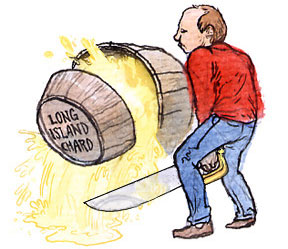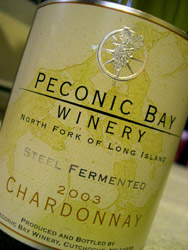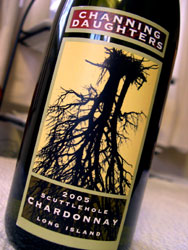

Many Long Island winemakers are cutting the oak
from their Chardonnay
Bring on the Steel -- The Chardonnay Shift is On
''The Long Island terroir is not suited for wines produced in a Napa Valley, California style.''
~ Barbara Shinn, Shinn Estate Vineyards
by
Lenn Thompson
March 3, 2006
Heavy, over-manipulated Chardonnay is one of the wine community’s least appealing members, at least in the eyes, and palate, of this wine lover. Wine geeks often label these wines “flabby” but I compare drinking them to sucking on a butter-slathered two by four. And, despite what some sales-minded winemakers will tell you, pairing these wines with food is a crapshoot at best.
Of course, Chardonnay is a key chameleon variety, with a seemingly endless array of styles. On one end you have crisp, fruity, acidic Chardonnays -- those that don’t spend any time in oak barrels during or after the fermentation process. These wines tend to be lighter yellow in color and their flavors lean toward green apples and tart citrus fruit with a crisp, clean mouthfeel.
On the opposite end of the style spectrum are Chardonnays that look like liquid gold. These wines have been born and raised in oak barrels and have often gone through a malolactic fermentation -- the conversion of malic acid to lactic acid -- which gives the wine a fuller, more viscous feel in the mouth. The flavor profile in these wines is also richer, with more baked apple, butterscotch, buttery toast, vanilla and even popcorn.
In Long Island vineyards, Chardonnay is the second most-planted variety (here, Merlot is King), and most wineries produce at least two different styles. As Alexandra Macari of Macari Vineyards puts it, “some consumers, especially women, love the oak with the buttery style, while others prefer the more food friendly style of steel-fermented Chardonnays.”
While oaky, “California-style” Chardonnay remains immensely popular in the United States, there is a shift afoot towards less-manipulated wines that allow the fruit’s true identity to shine through. Macari thinks “…we all drank too many oaky (Chardonnays) in the late 80s and early 90s from California.” This has led to a proliferation of steel-fermented bottlings (or ones that are made mostly of steel-fermented wine).”
Long Island winemakers seem to be doing a particularly good job bringing the best out of Chardonnay fruit -- without being heavy handed with oak. Barbara Shinn, co-owner of Shinn Estate Vineyards explains their decision to make only one chardonnay -- a crisp, fruity one. “The Long Island terroir is not suited for wines produced in a Napa Valley, California style. (And our) customers have been very enthusiastic about our Chardonnay, even those who have sworn off of Chardonnay altogether.”
Slowly but surely, card-carrying members of ABC (“Anything But Chardonnay”) are trying Chardonnay again. Look for this trend to continue.
So how can you tell if that bottle of Chardonnay on the wine store shelf is heavy and buttery or crisp and fruity? It’s not always easy because wineries aren’t required to tell you that sort of information on the label. But, there are two hints that can help -- especially with wines produced on Long Island.
If you see the word “reserve” on a bottle and it costs over $20, chances are it was aged in oak barrels and will be a bit fuller bodied and have some toasty or butterscotch character. Wines raised in oak barrels cost more because the barrels are expensive. Some bottles from other regions, like Australia or California, will label steel-fermented wines as “naked” or simply “unoaked.”
It’s important to remember that relatively few local Chardonnays, even if they are barrel fermented and aged, fall into the “flabby” category. The climate that makes the East End so ideal for grapes usually results in enough acidity to bring balance. And, most local winemakers seem reluctant to pummel us with oak.
Some Long Island steel-fermented Chardonnays, to try are:
~ Lenn Thompson, Long Island Editor
To comment on Lenn Thompson’s writings and thoughts, contact him at l.thompson @appellationamerica.com
Of course, Chardonnay is a key chameleon variety, with a seemingly endless array of styles. On one end you have crisp, fruity, acidic Chardonnays -- those that don’t spend any time in oak barrels during or after the fermentation process. These wines tend to be lighter yellow in color and their flavors lean toward green apples and tart citrus fruit with a crisp, clean mouthfeel.
On the opposite end of the style spectrum are Chardonnays that look like liquid gold. These wines have been born and raised in oak barrels and have often gone through a malolactic fermentation -- the conversion of malic acid to lactic acid -- which gives the wine a fuller, more viscous feel in the mouth. The flavor profile in these wines is also richer, with more baked apple, butterscotch, buttery toast, vanilla and even popcorn.
In Long Island vineyards, Chardonnay is the second most-planted variety (here, Merlot is King), and most wineries produce at least two different styles. As Alexandra Macari of Macari Vineyards puts it, “some consumers, especially women, love the oak with the buttery style, while others prefer the more food friendly style of steel-fermented Chardonnays.”
While oaky, “California-style” Chardonnay remains immensely popular in the United States, there is a shift afoot towards less-manipulated wines that allow the fruit’s true identity to shine through. Macari thinks “…we all drank too many oaky (Chardonnays) in the late 80s and early 90s from California.” This has led to a proliferation of steel-fermented bottlings (or ones that are made mostly of steel-fermented wine).”

Long Island winemakers seem to be doing a particularly good job bringing the best out of Chardonnay fruit -- without being heavy handed with oak. Barbara Shinn, co-owner of Shinn Estate Vineyards explains their decision to make only one chardonnay -- a crisp, fruity one. “The Long Island terroir is not suited for wines produced in a Napa Valley, California style. (And our) customers have been very enthusiastic about our Chardonnay, even those who have sworn off of Chardonnay altogether.”
Slowly but surely, card-carrying members of ABC (“Anything But Chardonnay”) are trying Chardonnay again. Look for this trend to continue.
So how can you tell if that bottle of Chardonnay on the wine store shelf is heavy and buttery or crisp and fruity? It’s not always easy because wineries aren’t required to tell you that sort of information on the label. But, there are two hints that can help -- especially with wines produced on Long Island.
If you see the word “reserve” on a bottle and it costs over $20, chances are it was aged in oak barrels and will be a bit fuller bodied and have some toasty or butterscotch character. Wines raised in oak barrels cost more because the barrels are expensive. Some bottles from other regions, like Australia or California, will label steel-fermented wines as “naked” or simply “unoaked.”

It’s important to remember that relatively few local Chardonnays, even if they are barrel fermented and aged, fall into the “flabby” category. The climate that makes the East End so ideal for grapes usually results in enough acidity to bring balance. And, most local winemakers seem reluctant to pummel us with oak.
Some Long Island steel-fermented Chardonnays, to try are:
- Channing Daughters Winery, Scuttlehole Chardonnay ($14)
- Macari Vineyards, 2003 Estate Chardonnay ($14.99)
- Peconic Bay Winery, 2003 Steel Fermented Chardonnay ($12.99)
- Raphael, 2004 Grand Cru ($15)
~ Lenn Thompson, Long Island Editor
To comment on Lenn Thompson’s writings and thoughts, contact him at l.thompson @appellationamerica.com












